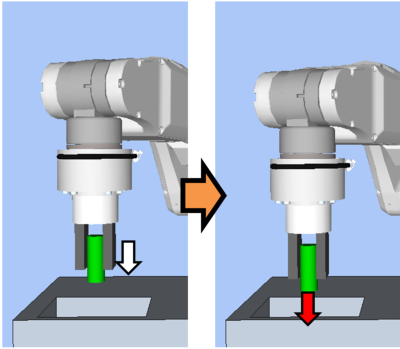Press Object
The Press object is the Force Guide object that operates the robot so that it presses with the specified force in the specified direction.
Also, it is possible to follow another specified direction simultaneously like Relax object.
If the Press object is executed in the non-contact state, the robot will move in the direction of the specified force. Use this object for press motion or pushing of assembly. Even if the workpiece dimension or the grasp position of the workpiece have a margin of error, the robot can keep a certain force stably.

The figure above shows a motion by the Press object. When executing in the non-contact state, the robot moves to the pressing direction (white arrow). After the robot contacts with the object, it keeps a state with a certain force (red arrow) is applied. You can start the object with a contact state.
The Press object succeeds if the end conditions are satisfied within the specified time. The Press object can use the end conditions related to force, position, and I/O.
Each end condition sets whether to use in ForceCheckEnabled, PosCheckEnabled, and IOCheckEnabled. If no end condition is set, the object will always be succeeded.
When more than one end conditions are set, you can select how to combine the end conditions from AND or OR in EndCheckOperator.
Each condition is as follows:
End condition | Success condition |
|---|---|
| End conditions related to force | During the specified Timeout period, keep all of the following conditions satisfied for the length of the HoldTimeThresh period: |
When ForceCheckPolarity is Inside: In Fx, Fy, and Fz, the axis specified to Press- or Press+ by Control Mode is inside the range of PressForce - PressCheckTolF to PressForce + PressCheckTolF. | |
When ForceCheckPolarity is Outside: In Fx, Fy, and Fz, the axis specified by Press- or Press+ in ControlMode is outside the range of PressForce - PressCheckTolF to PressForce + PressCheckTolF. | |
When ForceCheckPolarity is Inside: In Tx, Ty, and Tz, the axis specified Press- or Press+ by ControlMode is inside the range of PressForce - PressCheckTolT to PressForce + PressCheckTolT. | |
When ForceCheckPolarity is Outside: In Tx, Ty, and Tz, the axis specified by Press- or Press+ in ControlMode is outside the range of PressForce - PressCheckTolF to PressForce + PressCheckTolF. | |
ForceCheckMode is PressFollow and ForceCheckPolarity is inside: In Fx, Fy, and Fz, the axis specified Follow in ControlMode is within the range of -FollowCheckTolF to +FollowCheckTolF. | |
When ForceCheckMode is PressFollow and ForceCheckPolarity is Outside: In Fx, Fy, and Fz, the axis specified Follow by ControlMode is outside the range of -FollowCheckTolF to +FollowCheckTolF. | |
ForceCheckMode is PressFollow and ForceCheckPolarity is inside: The axis, which is specified to Follow by , ControlMode in Tx, Ty, or Tz: The axis should be within the range of -FollowCheckTolT to +FollowCheckTolT. | |
When ForceCheckMode is PressFollow and ForceCheckPolarity is Outside: In Tx, Ty, and Tz, the axis, which is specified Follow by ControlModeis outside the range of -FollowCheckTolT to +FollowCheckTolT. | |
related to position End condition | Satisfy either one of the following within the specified time of Timeout: |
When PosCheckType is RobotPlane: Satisfy the state set by PlaneEndCondition for Plane set by PlaneNumber. | |
When PosCheckType is RelativePlane: Satisfy the state set by PlaneEndCondition for the relative plane set by PlaneRelativeX, PlaneRelativeY, PlaneRelativeZ, PlaneRelativeOrg, PlaneRelativeOrient, PlaneAxes, PlaneRelativeRobotLocal. | |
| End conditions related to I/O | Input bit specified by IOCheckInputBit should be the state specified by IOCheckInputStatus within the time specified by Timeout. |